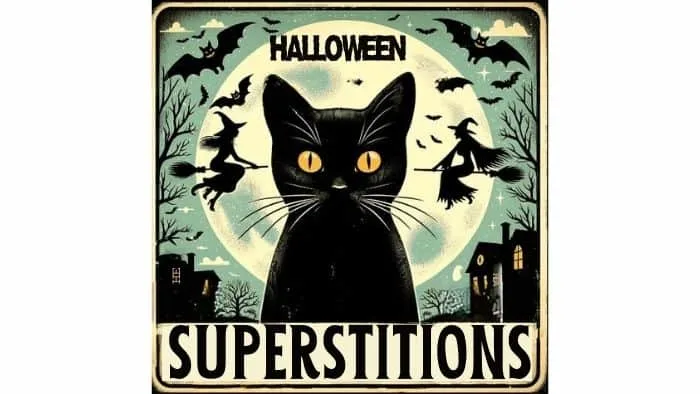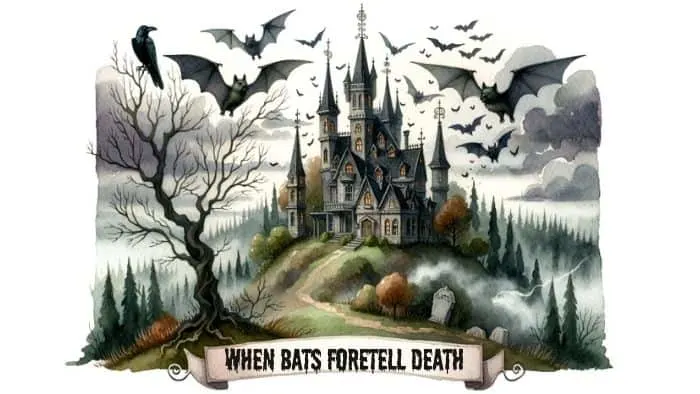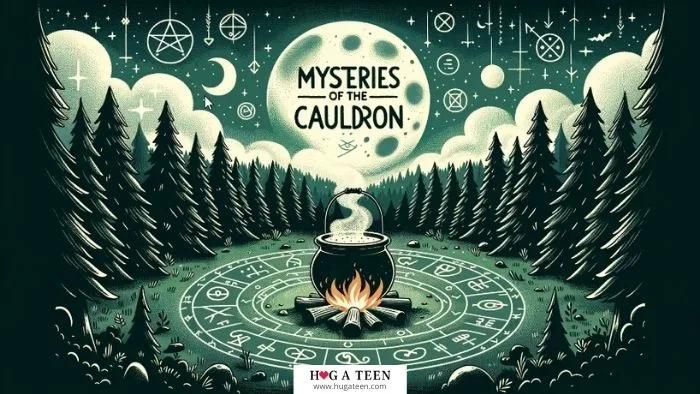Ever wondered about the origins and truth behind Halloween superstitions? You’re not alone!

Why Do Halloween Superstitions Exist?
The tapestry of Halloween is woven with tales of ghouls, ghosts, and all things eerie. But it’s also rich with Halloween superstitions that have been passed down through generations.
Rooted in pagan beliefs and ancient rituals, these common superstitions have shaped the way we celebrate the spookiest day of the year. They serve as a bridge between our world and the supernatural, offering glimpses into the unknown.
- Why Do Halloween Superstitions Exist?
- Spooky Superstitions Associated with Halloween
- 1. Avoid Black Cats
- 2. Carve a Jack-O-Lantern to Guide Lost Spirits
- 3. Seeing Bats Could Equal Death
- 4. Spiders
- 5. Witches
- 6. Cauldrons
- 7. Broomsticks
- 8. Dress Up to Fool Spirits
- 9. Give Treats to Avoid Angering Ghosts
- 10. Orange and Black
- 11. "Devil's Night" of Mischief
- 12. Throw Stones Into The Fire
- 13. Be Careful at Crossroads on Halloween
- 14. Blue Flames as Ghost Detectors
- 15. Wave a Fiery Stick for Good Luck on Halloween
- Frequently Asked Questions about Halloween Superstitions
Spooky Superstitions Associated with Halloween
In the early 1900s, Irish immigrants brought this tradition to North America. The origin of Halloween dates back to the ancient Celtic festival of the dead Samhain (“summer’s end”) and later Christian celebrations of martyrs and saints (“All Saints Day” or “All Hallows”).
Several medieval superstitions can be found in customary Halloween traditions today.
1. Avoid Black Cats

Ever cross paths with a black cat and wonder if bad luck will befall you? In many Western cultures, this feline rendezvous heralded misfortune. But why? The tale dates back to the Middle Ages when black cats were linked with witches.
Seen as demonic animals, they were believed to be mystical companions of witches or even witches transformed into cats to go unnoticed. Thus, seeing one might mean a witch was nearby. Some even believed them to be an incarnation of satan, triggering church-sanctioned witch hunts.
However, in other cultures, black cats are seen as good luck. So the next time you see one, give it a friendly nod and move on.
🎃 You might also enjoy these Easy & Cute Halloween Drawing Ideas (with Tutorials!)
2. Carve a Jack-O-Lantern to Guide Lost Spirits
Imagine the ghostly flicker of candlelight from within a carved pumpkin, casting eerie shadows in the darkness. This tradition isn’t just for kicks; it originates from an Irish myth.
Celtic folklore tells the tale of Stingy Jack, a notorious deceiver who managed to trick the Devil, but his cunning also barred him from both Heaven and Hell. Condemned to roam Earth, he used a carved turnip with a lump of coal ember as a lantern.
On Halloween night, Irish families who immigrated to America carved pumpkins to serve as beacons for lost souls, directing them home on Halloween.
3. Seeing Bats Could Equal Death

Have you ever had a bat flutter close on Halloween and felt a shiver run down your spine? The ancients might’ve nodded in agreement. Centuries ago, it was believed that if a bat flew around one’s house or entered it on Halloween, it meant that spirits were near and someone from the house was about to meet their maker. Quite the grim harbinger for such a small creature!
4. Spiders
Those eight-legged critters spinning silken tales of old! In ancient lore, spiders, especially when spotted on Halloween, were seen as the spirits of deceased loved ones watching over you. Their webs, often associated with fate and time, connected our world with the other side. So, if you find one lurking in a corner this Halloween, maybe it’s just grandma saying hello.
5. Witches
Ah, the iconic Halloween figure, cloaked in dark robes and flying on a broomstick. But where did this image come from? Witches, in many ancient societies, were revered as wise women and healers.
However, during the medieval period, the story of witches changed whereby they were demonized and associated with evil deeds. Their nocturnal meetings, or “sabbats,” were said to peak on Halloween, making their association with this day both haunting and timeless.
6. Cauldrons

Cauldrons bubble with old-world magic. Often linked with witches, these large pots symbolize transformation and rebirth. Legends speak of cauldrons containing magical brews, potions, or even the elixir of life.
On Halloween, they’re a reminder of the ancient rituals and the mysteries of the unknown.
🎃 You might also enjoy these Scary Halloween Dares For Teens & Tweens
7. Broomsticks
Zipping across the moonlit sky on a broomstick — quite the Halloween image, right? Broomsticks became associated with witches because of the old pagan fertility rituals. They’d jump high in the air with brooms between their legs, wishing for their crops to grow as high as they leaped.
Over time, tales morphed into the idea of witches flying on them, especially on Halloween night.
8. Dress Up to Fool Spirits
The origin of our beloved costume parties is steeped in spiritual camouflage. The Celts, during their Celtic festival of Samhain (Halloween’s precursor), believed that the veil between the living and the dead thinned.
By dressing up as a ghoul, you could fool the evil spirits into thinking that you were one of them so that they would not try to take your soul.
🎃 You might also enjoy these Ghoulish Halloween party games
9. Give Treats to Avoid Angering Ghosts
Ever wonder why we bribe kids with candy? Historically, treats were offered to placate roaming spirits, ensuring they’d pass by peacefully. Ignoring or angering them? That might result in a year of bad luck. So, it became customary to leave out offerings — an ancient insurance policy of sorts!
10. Orange and Black
The quintessential Halloween palette! Orange embodies the warmth of autumn harvests, while black signifies the encroaching darkness of winter and the boundary between life and death. Together, they encapsulate the essence of Halloween — a balance of life, death, and everything in between.
11. “Devil’s Night” of Mischief
Known as the eve of Halloween, “Devil’s Night” is synonymous with pranks and mischief. Rooted in the ancient belief that spirits roamed free the night before Halloween, any mischief or unexplained occurrences were attributed to these roaming entities. Over time, it’s evolved into a night of playful (and sometimes not-so-playful) human pranks.
12. Throw Stones Into The Fire

This eerie ritual involved inscribing one’s name or the name of a loved one on a white stone and casting it into a bonfire. If, by dawn, the stone was missing or damaged, it was a portent of death in the coming year. If they found their stone undamaged, it meant protection for the named individual in the year ahead. Talk about high stakes for a simple stone toss!
13. Be Careful at Crossroads on Halloween
Crossroads, where paths intersect, have always been seen as magical and unpredictable places. On Halloween, it’s said that spirits and faeries frequent these spots, making them places of heightened supernatural activity. A word to the wise: tread carefully, or better yet, take the long way around!
14. Blue Flames as Ghost Detectors
Legend has it that if you light a candle on Halloween and its flame turns blue, there’s a spirit close by. This spectral indicator was a way for the living to detect the presence of the otherworldly, giving them a chance to either greet or avoid their ghostly visitors.
15. Wave a Fiery Stick for Good Luck on Halloween
Sometimes, all you need is a blazing stick and some hope. Waving a stick set aflame around one’s head three times was believed to ward off evil influences and bring good luck.
Frequently Asked Questions about Halloween Superstitions
Why Do We Wear Costumes?
Another iconic Halloween superstition revolves around costumes. Ancient Celts believed that during Halloween, the boundary between our world and the spirit world became thin. To avoid being recognized by malevolent spirits, people would wear masks and costumes, blending in with the supernatural beings.
Why are spiders associated with Halloween?
Spiders are linked to Halloween superstitions because of their association with mystery, darkness, and the unknown. Ancient civilizations viewed spiders as weavers of fate. So, spotting a spider on Halloween was believed to be a sign that a loved one was watching over you.
Why do some people fear the number 13 on Halloween?
The fear of the number 13, known as triskaidekaphobia, isn’t exclusive to Halloween. It’s believed to have biblical origins, with Judas being the 13th guest at the Last Supper. However, on Halloween, this superstition intensifies, as people associate it with bad luck and dark forces.
Is it bad luck to celebrate Halloween?
Not at all! While Halloween superstitions abound, the holiday is all about fun, camaraderie, and sweet treats. Celebrating Halloween can be a delightful way to connect with friends, family, and ancient traditions. Embrace the mystery and enjoy!
As we draw the curtain on this deep dive into Halloween superstitions, remember to cherish the stories and beliefs, but don’t let them hold you back from having a spook-tacular celebration!
